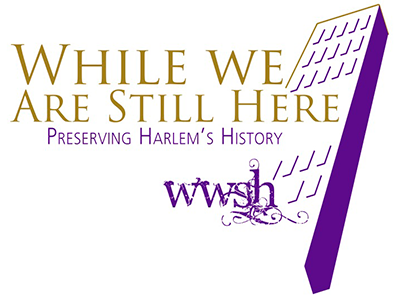They Lived at 409 Edgecombe
Katherine Butler-Jones
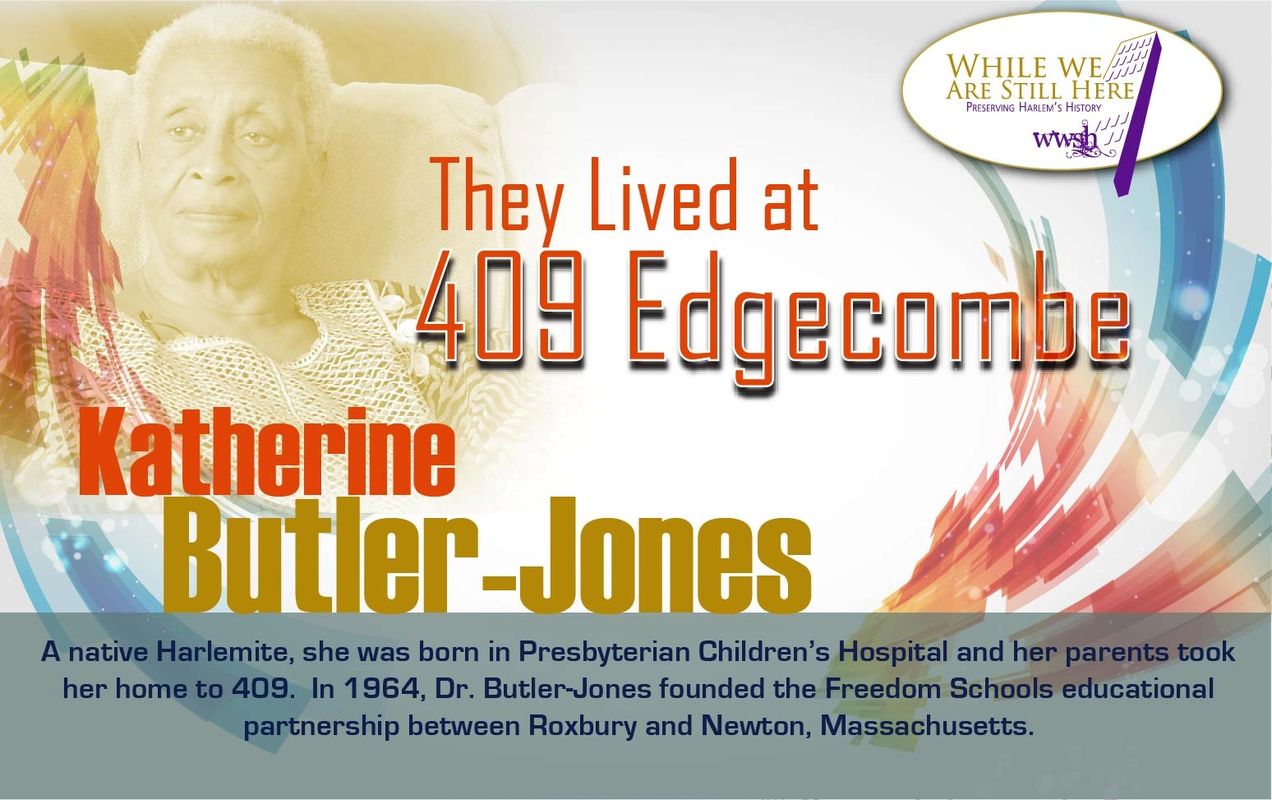
Educator, playwright, and author, Butler Jones grew up at 409 Edgecombe Avenue, and, judging by her literary output and the oral history she shared with While We Are Still Here, the people in that building helped shape her creativity. Describing 409 as a socio-economically mixed residence, where one could find, “doctors, lawyers, a number runner, hot goods, and a hairdresser,” among other types of folk, Butler Jones transformed her early experiences into a play called 409 Edgecombe Avenue: The House On Sugar Hill. She also penned an essay in Herb Boyd’s Harlem Reader about Madam Stephanie St. Clair, the numbers queen of Harlem, who also lived at 409. Of Butler Jones’s memoir, Deeper Roots: An American Odyssey, Boyd stated, “…How wonderful to relive these splendid moments with a superb storyteller."
Aaron Douglas

The Artist at Work
Because of the illustrations he created for philosopher Alain Locke’s influential work, The New Negro, Aaron Douglas was the visual artist of choice for many African American authors and publications. Douglas’s work shows his full embrace of Locke’s conception that Black artists should look to Africa for artistic inspiration.
Through his artwork that graced the pages of works that include James Weldon Johnson’s God’s Trombones and Fire!, a journal edited by Langston Hughes, Zora Neale Hurston, and Wallace Thurman, and through the body of his work as an illustrator, graphic designer, and muralist, Douglas was dubbed “the father of Black Art.”
Marvel Cooke
Marvel Cooke On Her Career, Organizing a Union Drive, and Joining the Communist Party
Upon coming to Harlem from Minneapolis, Marvel Cooke landed in the cultural vortex of the Renaissance era. She worked as W.E.B. Du Bois’s assistant at Crisis magazine, and, ultimately, made a name for herself as a journalist, labor organizer, and activist. Marvel Cooke was the first woman reporter at the Amsterdam News. Her circle of friends, comrades, and acquaintances included Richard Wright, Elizabeth Catlett, Countee Cullen, and Ella Baker, with whom she publicized the plight of Black domestic workers in an article, “The Bronx Slave Market.” In a foray into immersion journalism, Marvel went under cover as a domestic worker to deepen the previous expose. She, like Shirley Graham Du Bois, was active in the Communist Party. Marvel, like Louise Patterson Thompson, was active in the movement to free Angela Davis.
W.E.B. Du Bois

Du Bois Discusses His Atlanta University Years (the first institution in the United States to offer courses in Black history).
W.E.B. Du Bois was a Pan-Africanist, scholar, sociologist, activist, editor, poet, and playwright, who, along with librarian, Regina Andrews, founded the KRIGWA Players in Harlem, during the Renaissance era. Housed in the basement of the 135th Street Branch of the New York Public Library, KRIGWA sought to produce plays written and acted by Black people.
This KRIGWA Players program includes art work by Aaron Douglas
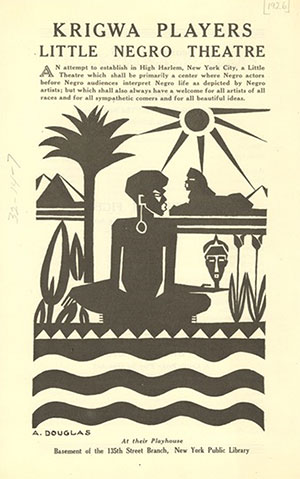
Shirley Graham Du Bois

Shirley Graham Du Bois On Imperialism and Neocolonialism
Bringing Tom Tom To Life
Shirley Graham Du Bois was a woman of many talents. In addition to composing Tom-Tom: An Epic of Music and the Negro, the musical covering the expanse of Black music, as of the 1930s, she was an author who penned biographies of Phillis Wheatley, Paul Robeson, Kwame Nkrumah, among others.
Her politics were decidedly Left and she was a member of the Communist Party USA for many years. Additionally, she was a confidant of President Kwame Nkrumah as well as another African head of state, Julius Nyerere, of Tanzania. Shirley Graham spent most of her life fighting against racial and capitalist injustice. She was a staunch supporter of the Chinese Revolution, and, as such, was highly respected by its leadership. She is buried in China.
Safiya Henderson-Holmes

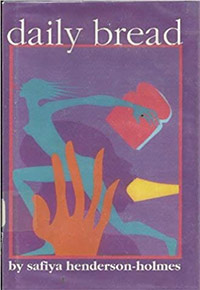 She was an assistant professor at the graduate Creative Writing Program at Syracuse University. Henderson-Holmes published two books of poetry, Daily Bread, and Madness and a Little Bit of Hope, which won the Poetry Society of America’s William Carlos Williams Award. A committed activist, she was devoted to realizing her internationalist perspectives, and worked with projects and organizations such as Art Against Apartheid, the National Council of American-Soviet Friendship, and MADRE. There are those among us, who remember that on many a Mother’s Day, she took bouquets of flowers to her mother-sister-friends throughout New York City.
She was an assistant professor at the graduate Creative Writing Program at Syracuse University. Henderson-Holmes published two books of poetry, Daily Bread, and Madness and a Little Bit of Hope, which won the Poetry Society of America’s William Carlos Williams Award. A committed activist, she was devoted to realizing her internationalist perspectives, and worked with projects and organizations such as Art Against Apartheid, the National Council of American-Soviet Friendship, and MADRE. There are those among us, who remember that on many a Mother’s Day, she took bouquets of flowers to her mother-sister-friends throughout New York City.
James Weldon Johnson

Howard University Gospel Choir sings the Black National Anthem
February 12, 2022 was the 122nd anniversary of the first public rendition of “Lift Ev’ry Voice and Sing.” The event took place in Jacksonville, Florida, the birthplace of James and his brother, J. Rosamond Johnson, who composed the music for the song. The very first performance of the song happened on February 12, 1900, by five hundred school children in Jacksonville to commemorate Abraham Lincoln’s birthday.
The United States House of Representatives declared “Lift Ev ’ry Voice and Sing” the national hymn of the United States.
Thurgood Marshall
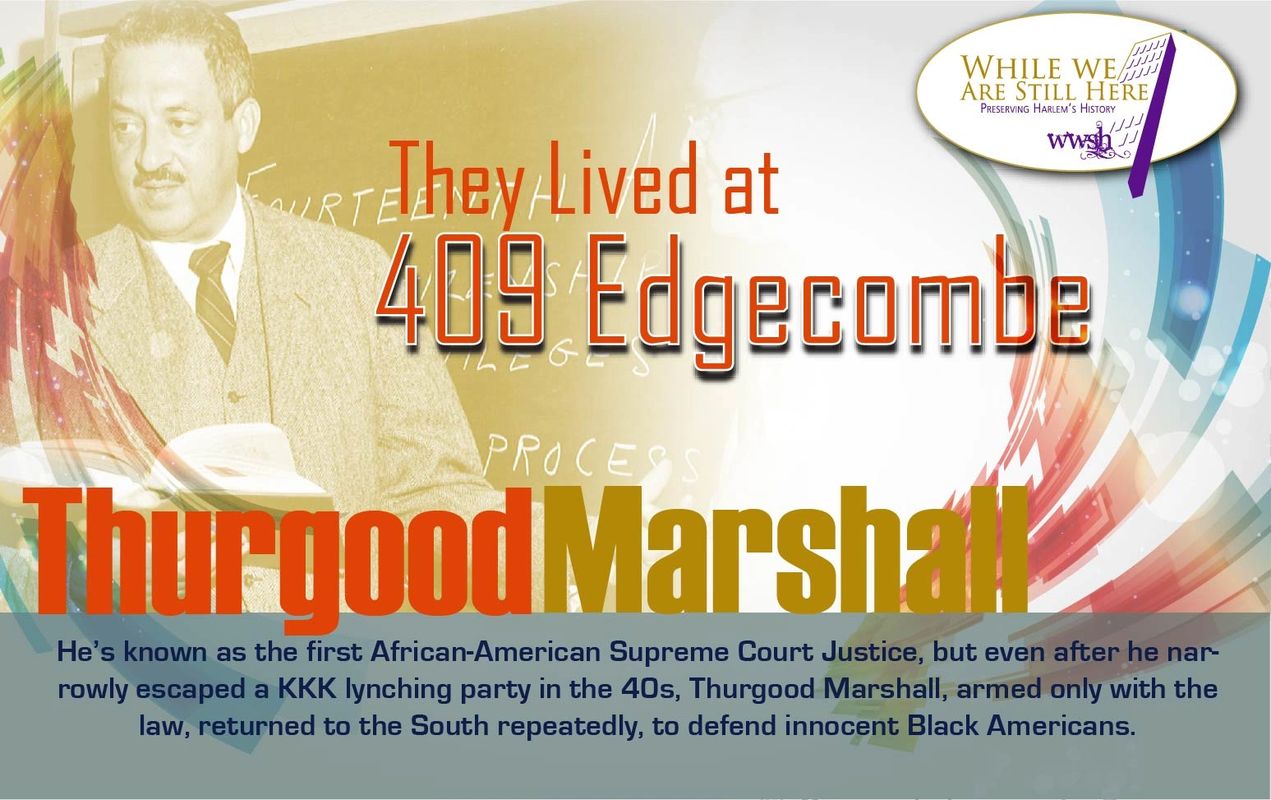
Thurgood Marshall is a historic icon, whose work symbolized the successes of the Civil Rights Movement of the 1950s and 1960s. But there is an elder at 409 who remembers him as her kind neighbor, who helped her push her cello up the steep hill on 155th Street, on her way to music lessons, when she was a girl.
To some Black, radical revolutionaries of the late 1960s, through the early 70s, organizations such as the NAACP, and individuals such as Marshall were considered too “accommodationist.” During that era, it would have been very interesting to find out how many Black revolutionaries knew that Marshall possessed an outsized bravery, along with his legal commitment to gain equality for African Americans.
All by himself, Marshall would get on the railroad from New York’s Penn Station, heading south, unarmed, to the scary, brutal hinterlands of America, where the Ku Klux Klan ruled. Marshall went to defend innocent Blacks, in towns where the judge was the Klan, the prosecutors were the Klan, the jury was the Klan, and darn near everybody else was the Klan.
For less-noted cases, he frequently traveled alone, but for trials that were public spectacle— Groveland, Florida’s case, for one—he had a team of attorneys. One of his colleagues, a Jewish attorney from New York, Jack Greenberg, saved Marshall from the noose and the torture he would have surely experienced at the hands of the lynch mob assembled in the backwoods of Florida. For many attorneys, a near lynching would have been enough to scare them away from continuing such dangerous work, but that didn’t stop Marshall, whose team went on to win the Brown v. Board of Education of Topeka, Kansas case, outlawing segregation. In his arguments, Marshall used the famous Doll Test that was developed by Drs. Mamie and Kenneth Clark, who lived at 555 Edgecombe Avenue. He retired from the United States Supreme Court in 1991, after serving for twenty-four years.
Madam Stephanie St. Clair
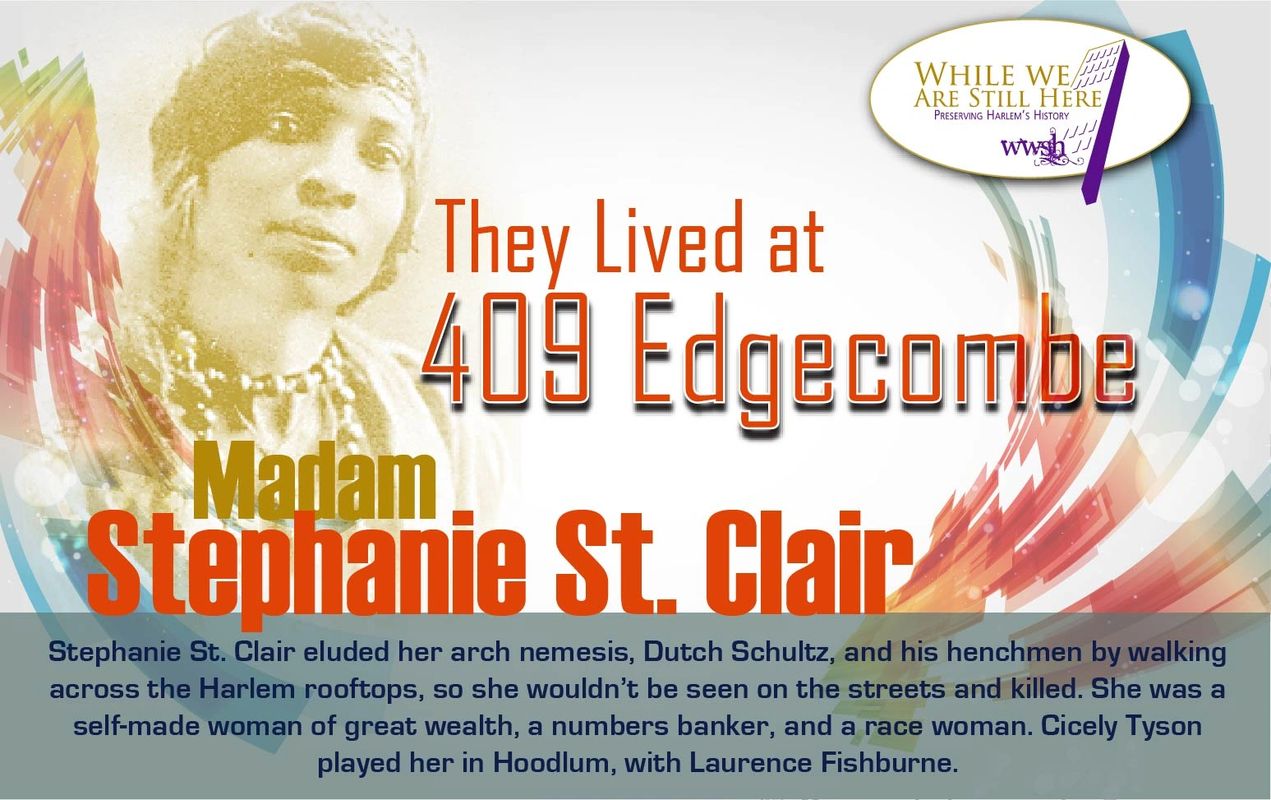
How did this woman, a Caribbean immigrant, become so successful in the numbers racket that the most notorious gangsters in New York City wanted to see her dead? For most Black women of that era, menial work was the only option. Obviously, St. Clair’s aspirations and attitude made a career as a servant an impossibility. Not much is known about her early life or even where in the Caribbean she was from, but the lasting legend of Madam Stephanie St. Clair says a lot about her time on Planet Harlem, where she controlled a large part of the uptown numbers action. And like many Black folk, regardless of their “profession,” St. Clair had clear political positions on the struggles for equality, and, frequently, wrote letters decrying oppression and police brutality. Through her pluck, savvy, and entrepreneurial genius, she became a millionaire and lived among the elite class of Harlem, some of whom were housed at 409 Edgecombe Avenue.
Louise Thompson-Patterson
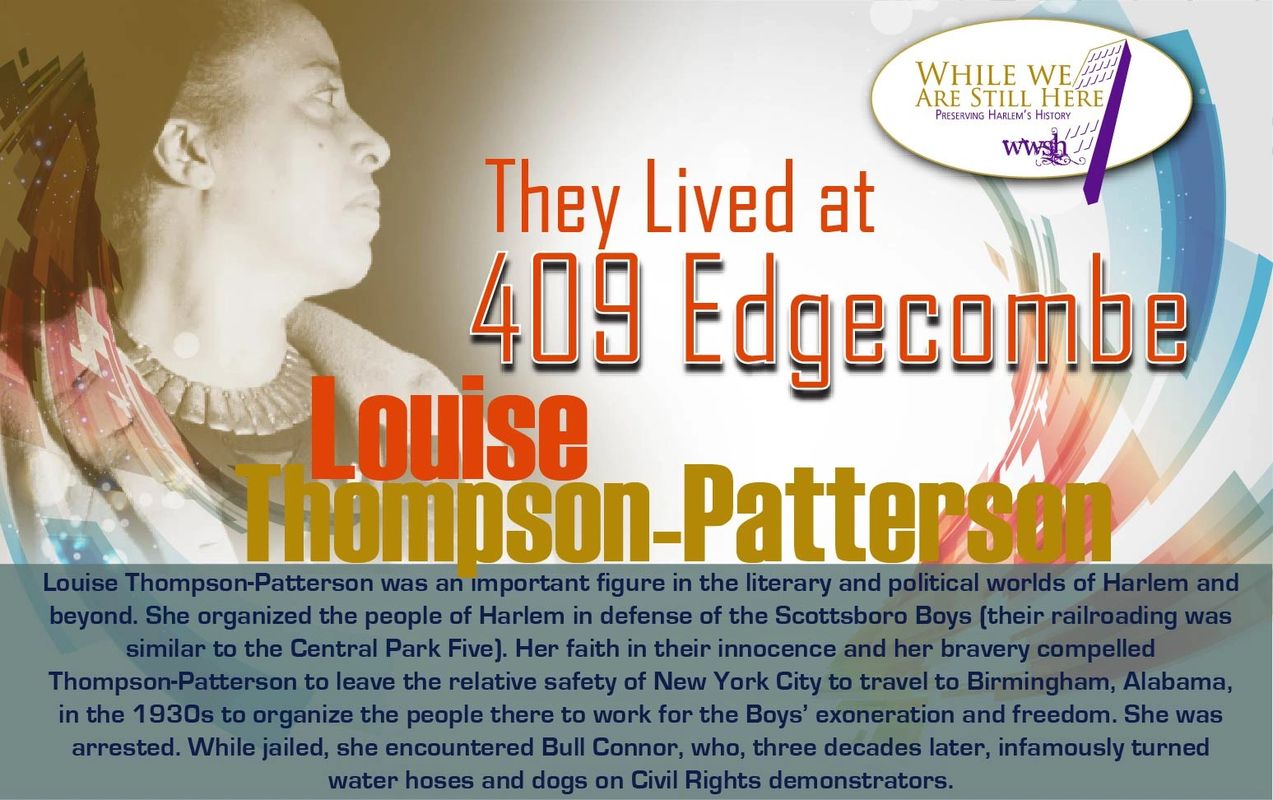
A Biographical Short
Last Words from Louise Thompson Patterson
She was also a literary figure, whose Vanguard Salon offered writers such as Langston Hughes and Zora Neale Hurston, a forum in which to share their works under development. She and Hughes enjoyed a decades’ long friendship and were political comrades. Together, they founded the Suitcase Theater.
Thompson Patterson was in the Movement for the long haul, and forty years after risking her life, organizing in Alabama, she worked for the freedom of Angela Davis. Driven by her credo, “No one is free until all are free,” as a Communist, Thompson Patterson devoted her entire life to struggling for world liberation from economic, racial, and gender-based inequities. For a time, she was married to William Patterson, an attorney for the Scottsboro Boys.
William “Pat” Patterson
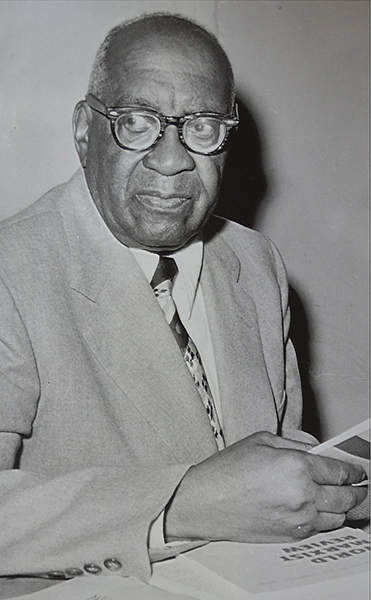
Attorney William Patterson defended Italian anarchists Sacco and Vanzetti. He was also at the forefront of the Scottsboro Boys case and publicized their plight internationally. Patterson led the Civil Rights Congress and was a victim of the McCarthy-era with hunts. He was imprisoned for taking the principled stance to not name names. He authored We Charge Genocide, the document that he and Paul Robeson presented to the United Nations, regarding the inhumane treatment that Black Americans had to endure. This treatise inspired Malcolm X. Patterson was also a long-haul revolutionary, who represented Angela Davis and the Black Panther Party. For a time, he was married to Louise Thompson-Patterson.
Reverend James Robinson
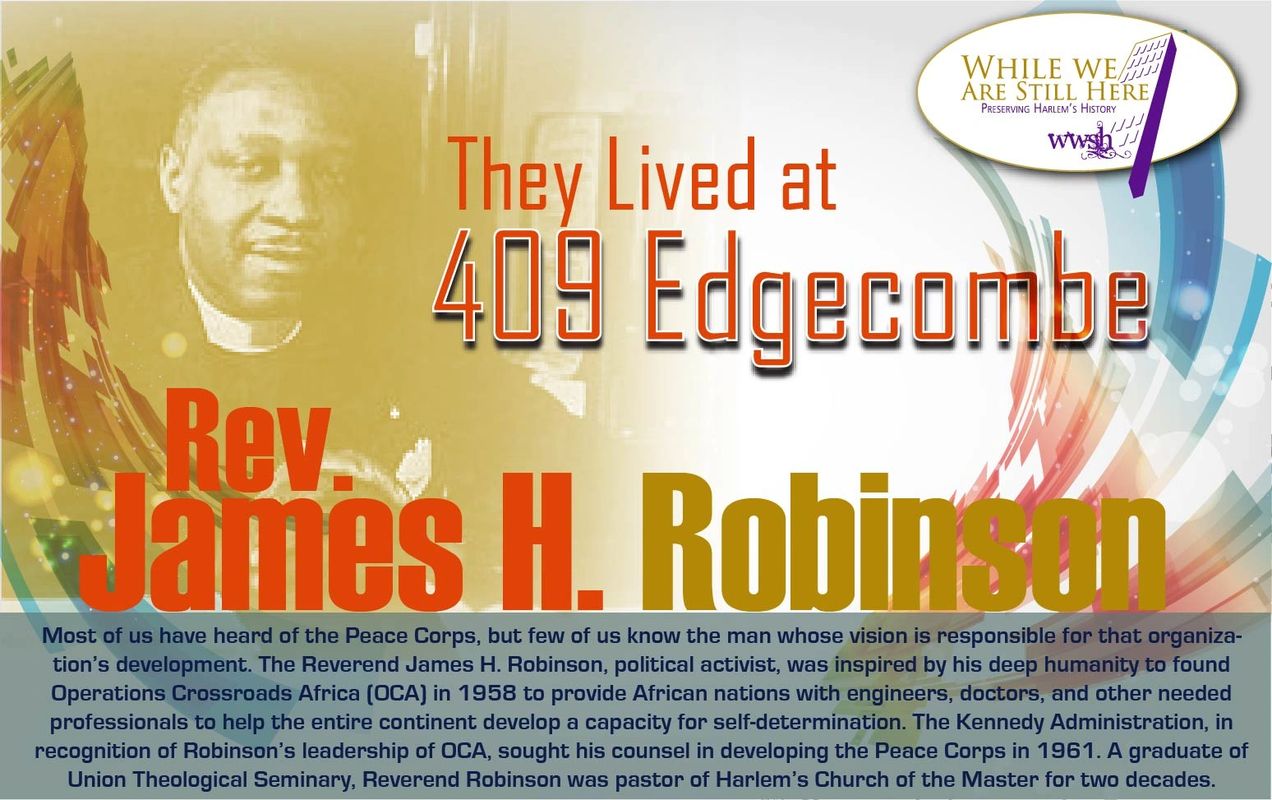
Though he was a missionary, he was not paternalistic, looking down on the African souls to whom he ministered. He felt that African Christians should be full partners in the Presbyterian Church that he was so deeply a part of. As the pastor of the Church of the Master, through his international travels to Africa, Asia, and the Middle East, Robinson was aware that the people of Harlem had the same issues that plagued many so-called Third World nations. He developed various community programs in Harlem, including a mental health clinic with trained psychologists, through the Morningside Community Center.
He was a supporter of the NAACP and the Urban League, and, because of his association with the NAACP, during the McCarthy with hunts, he was persecuted and had his passport temporarily revoked because of his association with the NAACP. He was not a Communist and did not support communism. When Reverend James Robinson began Operation Crossroads Africa, in 1958, one of his goals was to introduce Americans to the rich culture and histories of the nations on that vast continent. The organization the he founded is still in existence.
His work inspired the creation of the Peace Corps for whom he served as vice president and advisor.
Walter White

Walter White In His Own Words
Before his fifty+ year career as the executive secretary of the NAACP, Walter White was a journalist, who infiltrated the Ku Klux Klan. He had blonde hair and blue eyes and looked like a white man. In spying on the KKK, White took his life into his own hands. He was, eventually, found out, but escaped before the mob could find him. As a spy, however, he learned of the Klan’s inner workings and of the murders of forty Black people. Under his leadership, the NAACP became the most prominent civil rights organization in the country.
As a youth, Walter White stood at the window, beside his father, fearing that their home was going to attacked by a pack of whites with murder on their minds. White’s father said to him, “Don’t shoot until the first man puts his foot on the lawn—and then don’t you miss.”
Roy Wilkins
Roy Wilkins On the Immediate Need for School Desegregation
Roy Wilkins’s tenure as executive secretary began in 1955 and ended in 1977, but he previously held positions with the NAACP, as assistant secretary, under Walter White. Wilkins helmed the organization during notable events such as the NAACP Legal Defense and Education Fund’s victory in overturning school segregation in Brown v. Board of Education. The legal team included Charles Hamilton Houston, Thurgood Marshall, and Jack Greenberg whose arguments included the research of Drs. Mamie and Kenneth Clark.
Subscribe
Sign up to receive the While We Are Still Here periodic newsletter.
